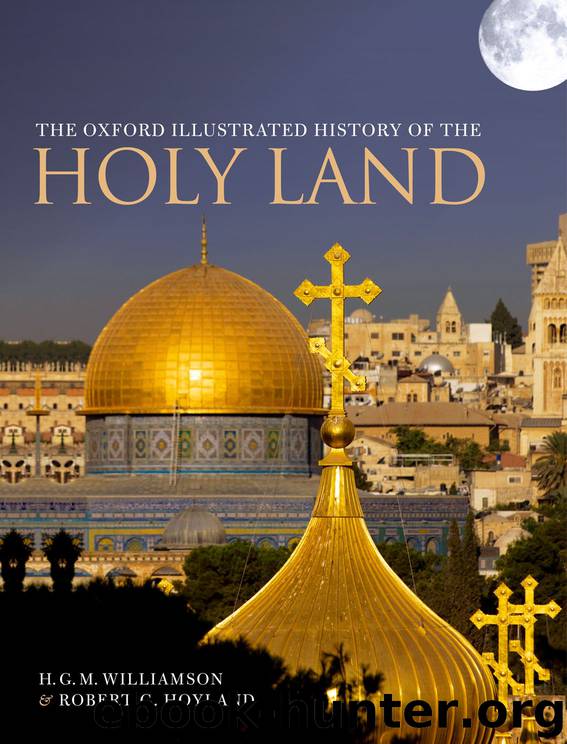The Oxford Illustrated History of the Holy Land by Robert G. Hoyland & H. G. M. Williamson

Author:Robert G. Hoyland & H. G. M. Williamson
Language: eng
Format: epub
ISBN: 9780191036477
Publisher: OUP Oxford
Published: 2018-06-24T16:00:00+00:00
Crac des Chevaliers, perhaps the most perfect of medieval castles, held by the Hospitallers from 1144 to 1271.
Fortified cities were no novelty in the Muslim Near East around 1100, as the walls of Cairo, Antioch, and Diyarbakr show, but it is instructive to note that the great fortified urban complexes of Syria and the Jazira—Aleppo, Damascus, and Harran among others—postdate the great Crusader castles of the 12th century and clearly owe much to them in a technical sense. However, the matter goes deeper than this. It was the Crusaders who so decisively militarized the Syro-Palestinian landscape, lands which before their arrival had no need of castles. The isolated Muslim castles of Palestine and Syria—‘Ajlun, Shayzar or the many Isma‘ili Shi’ite examples—are therefore also a response, though of poorer quality and on a much less ambitious scale, to the Crusader challenge. A parallel may be drawn with the many Armenian castles scattered all over Cilicia—‘Little Armenia’—which also reflect the inherent political instability of that short-lived kingdom, struggling to survive in a hostile environment.
Much can be deduced from both the sheer quantity of Frankish castles and their careful siting. Seen together rather than separately, they are clearly part of a strategic plan to appropriate and secure all the land that the Franks had conquered and were afraid to lose—hence their distribution across the length and breadth of the Frankish principalities. This aim explains their sometimes out-of-the-way location, such as that of Wuayra, near Wadi Musa beside Petra in the inhospitable extreme south, which had oversight of the route to the Red Sea. Many castles dominated important roads and could therefore threaten the enemy’s communication and trade networks while simultaneously protecting Christian pilgrims. Even a small garrison could with impunity sally forth from such castles in lightning attacks on caravans of merchants or Muslim pilgrims. The mere threat of such attacks was enough to inhibit travel. The disadvantages of a remote location could be offset by ensuring intervisibility and communication between castles, whether by means of fire, smoke, or reflected light. Not surprisingly, therefore, steep hilltop sites (which also discouraged the use of enemy siege engines, used by Saladin to devastating effect at Belvoir) were at a premium, as were coastal sites. Pigeon post was used for longer communications. Since the Franks were a beleaguered minority that suffered from a chronic and acute manpower shortage, castles were an ideal method of making a few men do the work of many, and they did not have to be huge to be effective. The early ones were hall keeps on two floors, or tall thin towers; as many as eighty small towers have been identified in the Kingdom of Jerusalem alone. A relatively small garrison could easily store enough water and provisions to make a small castle impervious to siege. A visitor to Margat in 1212 said that the castle contained enough provisions for five years. It was a good example of those castles that were built on a much more ambitious scale to serve
Download
This site does not store any files on its server. We only index and link to content provided by other sites. Please contact the content providers to delete copyright contents if any and email us, we'll remove relevant links or contents immediately.
| Africa | Americas |
| Arctic & Antarctica | Asia |
| Australia & Oceania | Europe |
| Middle East | Russia |
| United States | World |
| Ancient Civilizations | Military |
| Historical Study & Educational Resources |
Mediterranean Winter by Robert D. Kaplan(841)
Rivers of Power by Laurence C. Smith(835)
Berezina by Sylvain Tesson(722)
Earth: An Intimate History by Richard Fortey(715)
The Revenge of Geography: What the Map Tells Us About Coming Conflicts and the Battle Against Fate by Robert D. Kaplan(543)
Restigouche by Philip Lee(531)
Exceptional Mountains by O. Alan Weltzien(527)
The Coral Island: A Tale of the Pacific Ocean by R. M. Ballantyne(488)
Hidden Histories by Mary-Ann Ochota(488)
Heaven's Breath by Lyall Watson(478)
Position Doubtful: Mapping Landscapes and Memories by Kim Mahood(442)
The Ancient Paths by Graham Robb(437)
Cartographies of Time by Daniel Rosenberg & Anthony Grafton(420)
Delphi Complete Works of Strabo - Geography (Illustrated) (Delphi Ancient Classics Book 61) by of Amaseia Strabo(415)
Time and Navigation by Andrew K. Johnston(401)
Nature's Mutiny by Phillip Blom(389)
The Oxford Illustrated History of the Holy Land by Robert G. Hoyland & H. G. M. Williamson(374)
A Short History of the World in 50 Places by Jacob F. Field(366)
Putting Science in Its Place by Livingstone David N(360)
